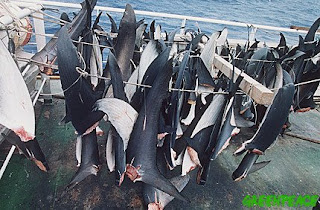
What IS Shark Fin Soup?
Shark fin soup (or shark's fin soup) is a Cantonese cuisine delicacy commonly served as part of a Chinese feast, usually at special occasions such as weddings and banquets as a symbol of wealth and prestige. The "finning" of sharks required to make this soup has been highly controversial. Some have called the practice brutal, and it is also named as a primary contributing factor in the global decline of many shark species. China's booming economy has resulted in a large increase in demand for shark fins, and this, combined with the importance of this predator in oceanic ecosystems, has exacerbated the problems that the practice is said to perpetuate.

Finning = Death
According to wildlife conservationists, much of the trade in sharks' fins is derived from fins cut from living sharks; this process is called finning. Because shark meat is worth very little, the finless and often still-living sharks are thrown back into the sea to make room on board the ship for more of the valuable fins. When returned to the ocean, the finless sharks, unable to move, either die from suffocation or are consumed by other sharks or animals.

Finning is vigorously opposed by animal welfare groups; both on moral grounds and also because it is listed as one of the causes for the rapid decline of global shark populations.On the IUCN red list there are 39 species of elasmobranches (sharks and rays) listed as threatened species (Critically Endangered, Endangered, or Vulnerable). The Convention on International Trade in Endangered Species of Wild Fauna and Flora (CITES) lists three sharks in Appendix II: the basking shark, the great white shark and the whale shark. Appendix II lists those species that are not in danger of extinction, but which require controls on international trade to maintain their populations. It is estimated that 10–100 million sharks are slaughtered each year for their fins, with a median figure of 38 million. The industry is valued at US$1.2 billion; because of the lucrative profits, there are allegations of links to organized crime. They also raise questions on the medical harm from the consumption of high levels of toxic mercury reportedly found in shark fins.

Numbers of some shark species have dropped as much as 80% over the last 50 years. Some organizations claim that shark fishing or bycatch (the unintentional capture of species by other fisheries) is the reason for the decline in the populations of some species and that the market for fins has very little impact - bycatch accounts for an estimated 50% of all sharks taken- others that the market for shark fin soup is the main reason for the decline.






